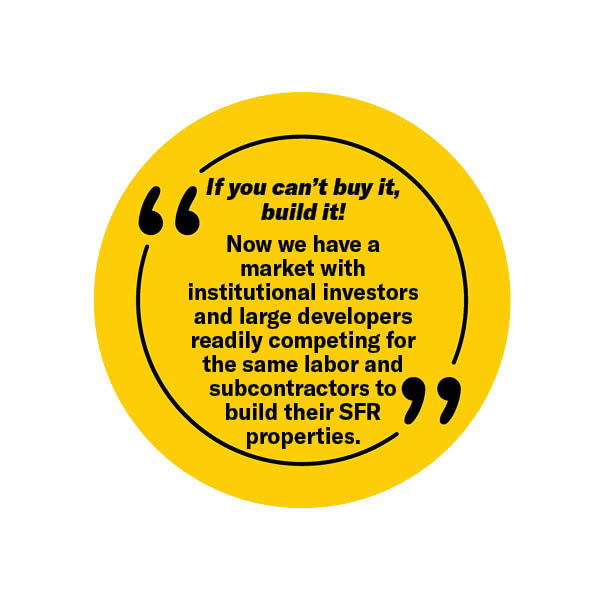The single-family rental (SFR) market has historically been dominated by small investors and has never been attractive to institutional or large-scale investors. Single-family homes have always been considered too expensive to maintain and too difficult to manage, making it easier and more cost-effective to build large multifamily projects.
But that has changed in recent years. Top 10 builders such as D.R. Horton, Lennar, and Pulte, are partnering with large capital firms to create single-family, for-rent ventures.
We’re even seeing institutional investors diving headfirst into the SFR market. Companies like Amherst and Invitation Homes see revenue opportunities in rentals. Tenants want to live in single-family homes and these companies are finding profitable ways to deliver them.
But guess what? There isn’t any inventory for them to buy. For example, if you are an investor and need 300 homes in Charlotte, N.C., chances are you won’t be able to find 300 homes there to purchase. What are your options? In our inflationary time, idle capital that’s not working is, in fact, losing value. That money needs to be put to work, but how?
The answer a lot of investors are coming to is that if you can’t buy it, build it. That means institutional investors in the SFR market are now competing with existing builders and developers in the traditional for-sale market for skilled workers and subcontractors. But, of course, there aren’t enough workers or subs to meet everyone’s needs, and, in fact, those existing builders and developers have already tied them up.
Enter offsite modular construction. There are already enough complications when it comes to locating, purchasing, permitting and prepping a lot to build a single-family home, and that’s before you even start the process of managing a site build. Offsite modular construction can simplify the actual building of the house.

Another big advantage of modular is that the home will get completed in a fraction of the time required for a site build. That means the investor can start collecting rent months earlier (a point driven home by our “Modular Math 101” article in this issue).
Offsite modular construction can also adapt to any type of structure. It’s being used for large multifamily projects and is a great choice for duplexes and quadplexes. In fact, modular thrives on repeatability, so the key to success in the single-family market will be repeatable designs.
Fortunately, repeatability is easy to achieve in an SFR project, where design decisions are made by the builder and developer, not by a private homeowner. A SFR developer will want to limit production to a specific set of well-designed plans. These plans can be designed for factory production, for cost-effective transport, for efficient installation, and for quick on-site finishing.
There is no doubt that offsite construction will penetrate deeper into the SFR market. Large developers and investors are starting to build their own factories or are investing in existing factories. They’re seeing a healthy market for years to come. According to the latest Realtor.com study, the US is currently 6.5 million homes behind what it needs to meet demand.
Whether they are bought or rented, our families need homes to live in. Offsite construction offers the fastest path to providing those homes.
If you liked this article, you can follow Ken Semler on LinkedIn, where he offers daily insights and commentary about offsite construction.

















